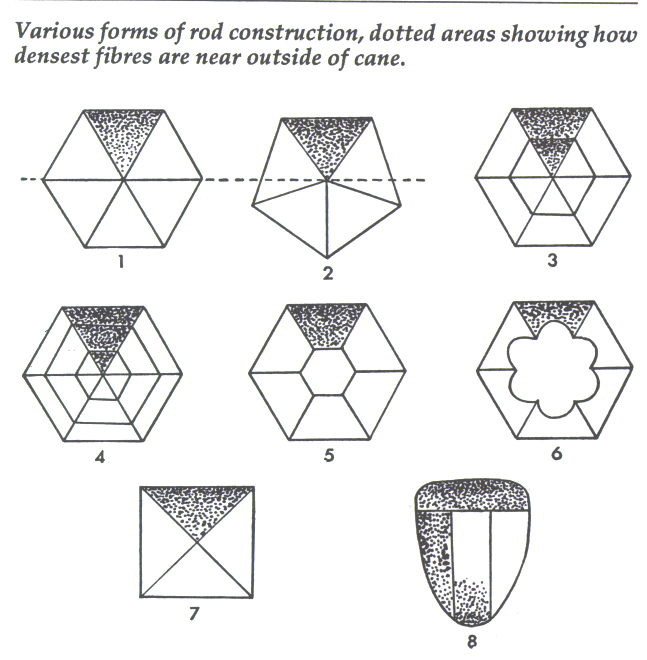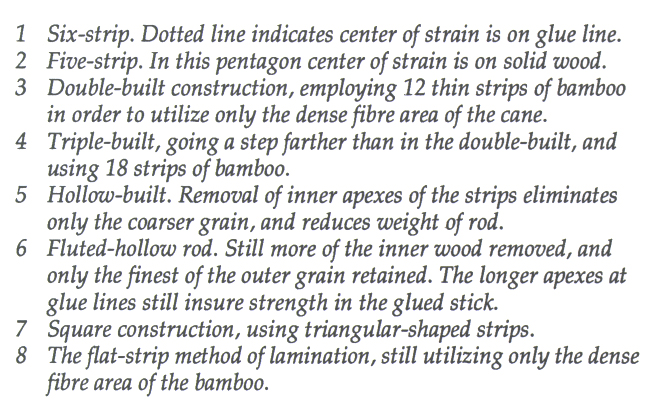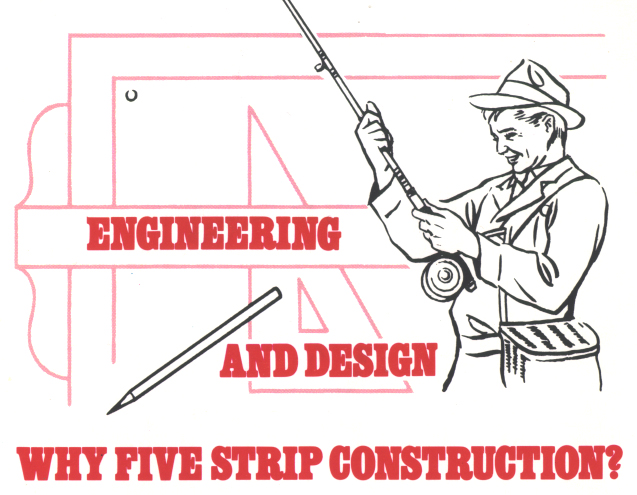Why are pentagonal (5 sided) rods superior to even sided rods? We have compiled the following excerpts and articles from various catalogs, books and magazines. It is our opinion that pentagonal rods are superior to even sided rods and offer more reserve power, cast more accurately and are less likely to take a "set". Just ask one of our customers. We have been developing our pentagonal tapers for many years and offer more Pentagonal actions than anyone else. We invite you to come in and cast one to feel the difference.
|
|---|
 |
Why Five Strip Construction? by Nat Uslan August 1974 When anything bends -- be it a tree in the wind -- an automobile spring -- an archer's bow -- or a fly rod, the material lying along the outside of the curve is stretched, while that along the inside is compressed. Were it not for the fact that every little element comprising, for example, the tree trunk were intimately united by nature, each would slide upon the next, thus enough so, in fact that but few glues in existence can equal its srength. The tendency of one element to slide over the next, while the rod is bent, is most pronounced along a line joining opposite corners of a rod built of an even number of strips. Therefore the glue line is called upon to resist the strongest internal stresses, a situation precisely the reverse of a proper arrangement.The simple expedient of substituting five slightly wider strips restores order. No continuous straight glue line extends through the center of the five strip rod section. The heavy sliding stresses are then borne by the bamboo rather than glue.
|
The bamboo rod and how to build it - by Claude M. Kreider 1951 Chapter 2 Methods of Rod Construction, page 11: "...The five strip rod definitely has unusual merit, as I can testify after building very many of them to Robert Crompton's charts, and others of experimental tapers. Beautiful five-strip rods of various types are now being produced commercially by the Uslan Rod Company of Spring Valley, New York. Perhaps other rod builders supply them to order for a limited clientele; and certainly a great many amateur craftsmen are enjoying the novelty of five-strip construction, with the satisfaction of producing very fine, useful and unusual rods of the marvelous bamboo fiber. Another definite advantage of five-strip construction is that the glue line is off center, the working strain being upon solid wood (note Fig. 2 in the illustration) rather than upon a continuous glue line in the six-strip, Fig. 1. Thus, the slipping, shearing tendency which must be present in the six-strip is entirely absent in the five-strip pentagon..." Chapter 9 The Five-Strip Rod, page 57: "This unique type of construction perhaps merits a fuller description than was undertaken in Chapter 2, since you may be undecided at the start whether to build this rod or the conventional six-strip. Here we are departing from the traditional hexagonal design, which has served so well for three quarters of a century, so the merits of five-strip construction should be carefully examined. In addition to the bracing effect of the apex opposing the flat, arched surface and the off-center glue line, as mentioned in Chapter 2, there is the undeniable fact, easily noted in the tests of a five- and six-strip rod of the same type, and containing the same weight of bamboo, that the five-strip has more power or backbone. The difference is particularly notable in fly rods, and is evident in rods of the bait casting type as well. I have not had the opportunity to compare heavier sticks in the two types, but feel sure that the five-strip construction such rods will prove unusually resistant to "set," which so often deforms such rods subjected to terrific strain in fighting large fish. Robert Crompton, a fine craftsman of the old school, with the enquiring, analytical mind of a trained engineer, is credited with this radical change in construction from the time-tried hexogonal rod, and he pioneered in this field a grat many years ago, experimenting with various rod tapers which resulted in proved working charts..." |
 |
 |
More penta info - Field & Stream Oct. 1948 article by Lou Feierabend titled Why Five? |
Specifications subject to change without notice. Copyright © 1998-2011 High Sierra Rod Company. All Rights Reserved. |
